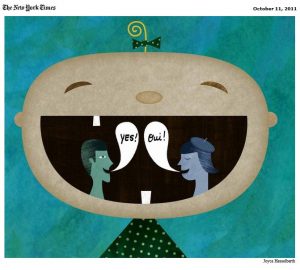The Science of Bilingualism in the News
[Source: The New York Times]

By PERRI KLASS, M.D.
Hearing Bilingual: How Babies Sort Out Language
Once, experts feared that young children exposed to more than one language would suffer “language confusion,” which might delay their speech development. Today, parents often are urged to capitalize on that early knack for acquiring language. Upscale schools market themselves with promises of deep immersion in Spanish — or Mandarin — for everyone, starting in kindergarten or even before.
Yet while many parents recognize the utility of a second language, families bringing up children in non-English-speaking households, or trying to juggle two languages at home, are often desperate for information. And while the study of bilingual development has refuted those early fears about confusion and delay, there aren’t many research-based guidelines about the very early years and the best strategies for producing a happily bilingual child.
But there is more and more research to draw on, reaching back to infancy and even to the womb. As the relatively new science of bilingualism pushes back to the origins of speech and language, scientists are teasing out the earliest differences between brains exposed to one language and brains exposed to two.
Read the Rest of this Article on the New York Times Website
PediaStaff is Hiring!
All JobsPediaStaff hires pediatric and school-based professionals nationwide for contract assignments of 2 to 12 months. We also help clinics, hospitals, schools, and home health agencies to find and hire these professionals directly. We work with Speech-Language Pathologists, Occupational and Physical Therapists, School Psychologists, and others in pediatric therapy and education.
